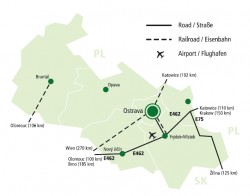Moravia-Silesia
Location and investment climate
The Moravia-Silesia region lies in the northeast part of the Czech Republic, bordering Poland to the north and Slovakia to the southeast, and contains four Euroregions: Beskydy, Praděd, Silesia and Těšínské Slezsko. Moravia-Silesia has always been one of the most important regions in the context of Bohemia, Moravia and Silesia. For example, in the Middle Ages, the famous Amber Trail traversed the region, and in the 19th century Moravia-Silesia became an economic centre of the then Austro-Hungarian Empire. The region's natural centre is Ostrava, the third most populous city in the Czech Republic, which together with the neighbouring towns comprises the country's most important industrial agglomeration.
Transport connections to neighbouring regions are ensured primarily by the Ostrava-Mošnov international airport, which is undergoing dynamic development and growth in the number of regularly scheduled and charter routes. The region is traversed by a modernised railway linking Prague, Olomouc and Ostrava. In only two years, the D47 highway will be opened and become part of the future north-south transcontinental route.
Moravia-Silesia is known for its rich industrial heritage. For two centuries, prominent industries in the region were those related to the discovery and mining of high-quality black coal in the Ostrava and Karviná areas. Naturally, the steel, chemical and mechanical engineering industries - all of which place great demand on energy resources - subsequently developed here. In combination with the restructuring of the 1990s, the overly one-dimensional economic structure of the region brought about a high rate of unemployment and social problems.
However, it appears that Moravia-Silesia has the worst of these problems behind it. Through thorough restructuring, the region's key enterprises, such as OKD a.s., Holding Vítkovice and Mittal Steel, have managed to cope and are now thriving. In addition to the above-mentioned companies, a network of SMEs is being developed in the region, often with the support of the state's grant policy. The Ostrava area has undergone greater changes than it would appear. In recent years the region's dynamic growth has been spurred by foreign investments, support for science and research, and assistance for SMEs, particularly with regard to innovation. Strategic industrial zones have grown up in Ostrava-Hrabová, Mošnov, Karviná, Kopřivnice and Krnov.
Today the region offers investors favourable conditions, particularly an abundance of educated people, high-quality universities (VŠB, University of Ostrava, Business School Ostrava, Silesian University), the strategic location of the CR, Poland and Slovakia and, upon completion of the D47 high, convenient transport routes. It is thus no accident that companies such as Asus, Sangwoo-Hitech, Bang & Olufsen s.r.o., Mölnlycke Health Care Klinipro s.r.o., Behr Czech s.r.o., Brose CZ, spol. s r.o. and others are operating in Moravia-Silesia today. The Hyundai plant being built in Nošovice warrants special mention. The services industry is also developing, a good example of which is GE Money's customer service centre.
Science, research, high technology, and innovation, and their use in production, have a growing impact on the region's economy. This is evidenced by the Ostrava Science and Technology Park, which operates in close cooperation with the Technical University in Ostrava. The establishment of clusters is another economically important factor. Moravia-Silesia is currently home to wood-industry, automotive and engineering clusters.
Leisure time and tourism
Moravia-Silesia is not only an industrial area. Whoever does not know the region will be pleasantly surprised by its beauty and points of interest. The region contains natural beauties, protected landscape areas and monuments to technology that cannot be found anywhere else, as well as a surprising number of cultural monuments. Moravia-Silesia's culture is suffused with Czech, Slovak and Polish influences, and the region has a rich background for sporting and cultural activities.
Sport is popular in the region. Lovers of summer hiking and winter sports can set out for Beskydy or Jeseníky. Beskydy's attractions include the Mionší nature preserve, the region's highest mountain, Lysá hora (1323 metres above sea level), and the Bílá and Pustevny ski centres. In Jeseníky, which is generally more rugged, skiing is possible until April on the "Moravian glacier" at the Ovčárna centre. Where competitive sports are concerned, the "Golden Track Shoe" track-and-field event, which regularly takes place at the beginning of the track-and-field season, has become world-famous. Among the regions important sports facilities is the ČEZ arena in Ostrava, which has hosted the ice hockey and handball world championships, the Davis Cup and other international events.
Culture in Moravia-Silesia is of the highest order. The Janáček Conservatory in Ostrava develops new talents, while many cities in the region have their own theatres, the most well-known of which are the A. Dvořák Theatre, Petr Bezruč Theatre and Jiří Myron Theatre. Colours of Ostrava, a leading summer festival, offers all types of music, and those who like their music with a harder edge can look forward to the Noc plná hvězd (Night of Stars) festival in Třinec. The Puppet Theatre and zoo in Ostrava are traditional favourites among children.
Moravia-Silesia has not renounced its industrial past. Those interested in the history of mining can view the unique exhibits at the Museum of Mining in Ostrava-Petřkovice u vrchu Landek, where the Landek Venus was discovered. The Vysoké pece complex in Ostrava-Vítkovice is without parallel in terms of its size and technical parameters.
People make the region, and Moravia-Silesia has its share of notable natives. The composer Leoš Janáček was born Hukvaldy, a small town between Frýdek-Místek and Příbor, the birthplace of the founder of psychoanalysis, Sigmund Freud. And neighbouring Kopřivnice is the home of the legendary athlete Emil Zátopek.
Attached files
| Description | Type | Size | Date |
|---|---|---|---|
Moravia-Silesia Region |
564.29 kB | 28 Apr. 2017 |









